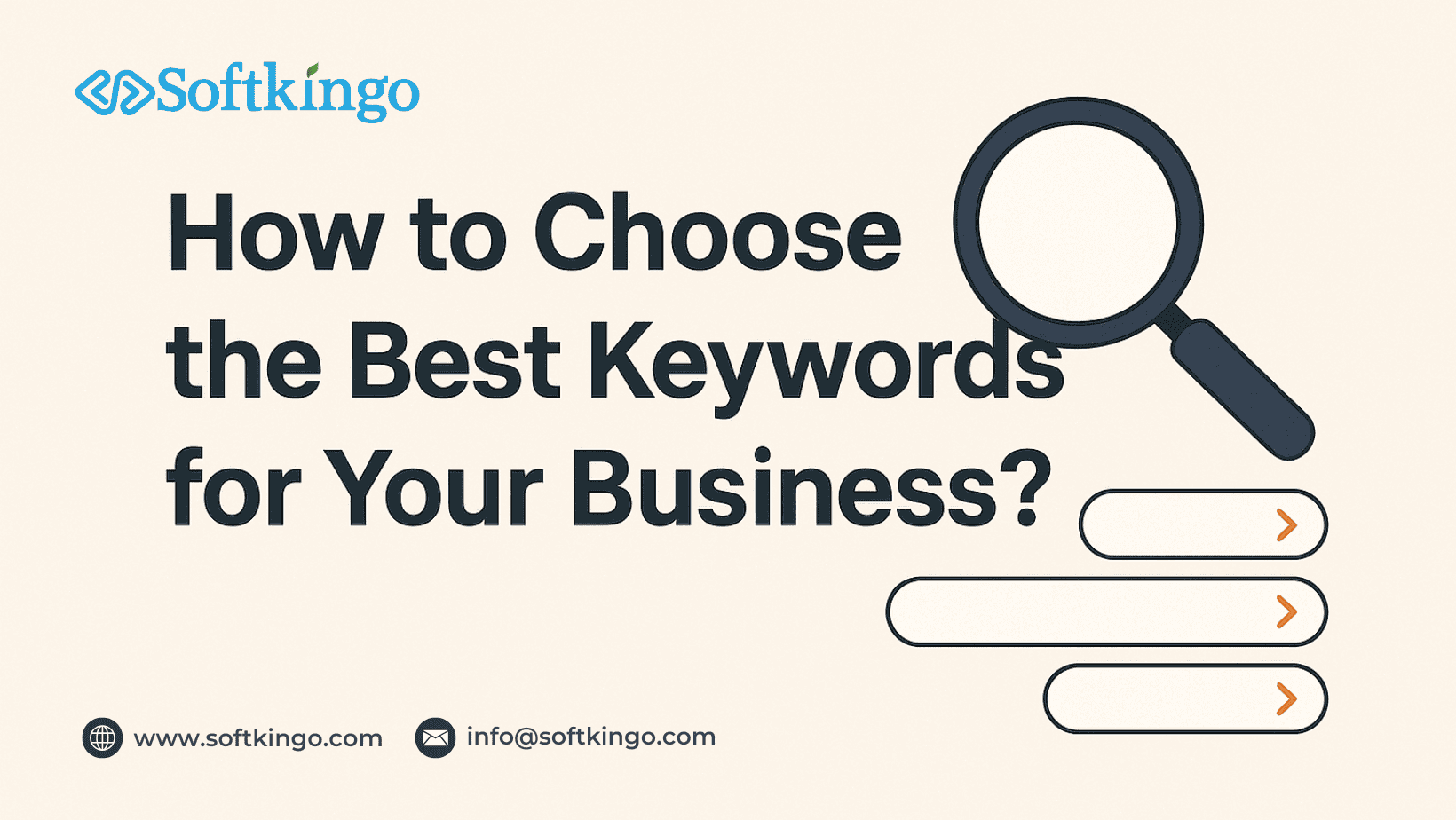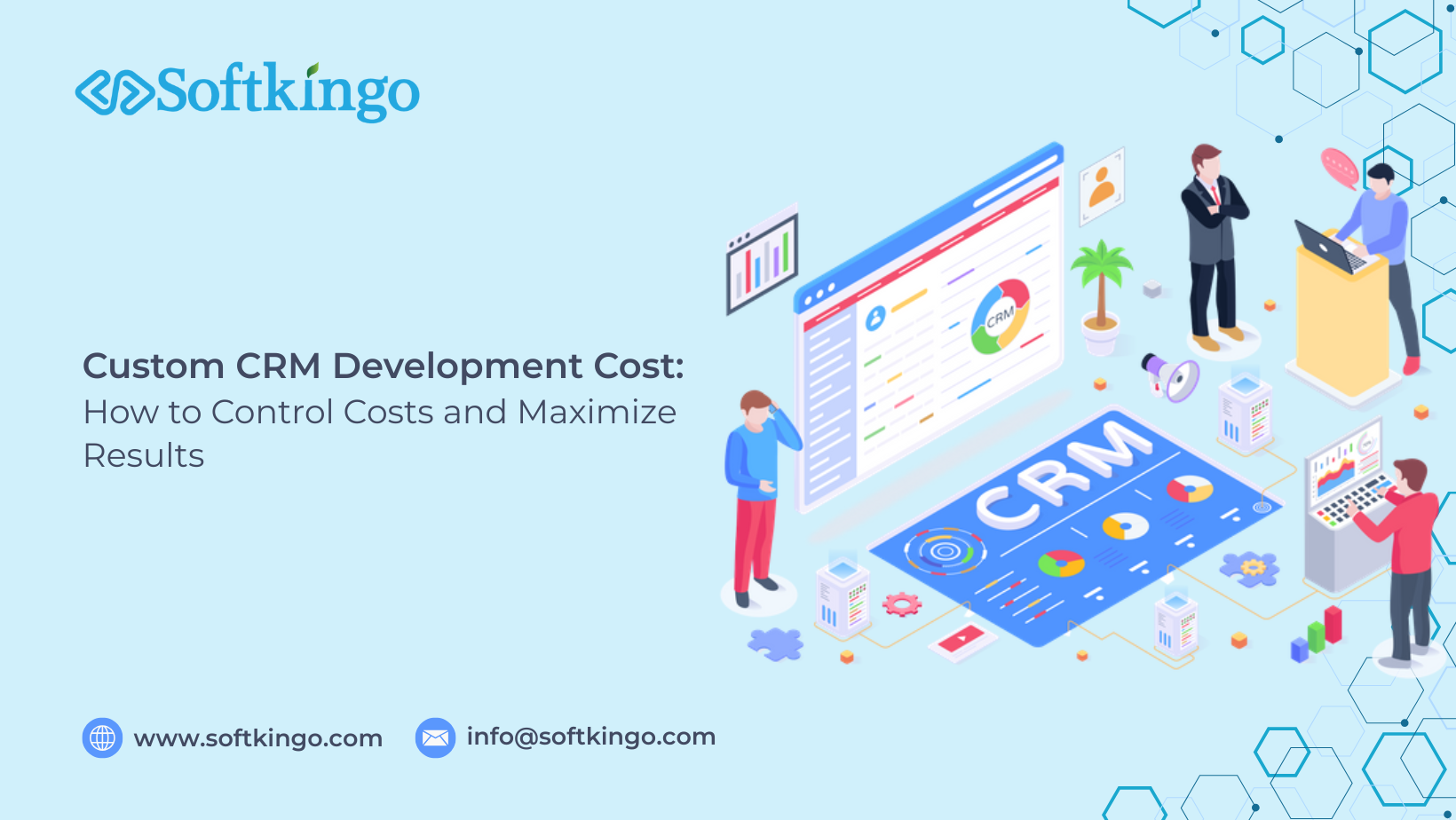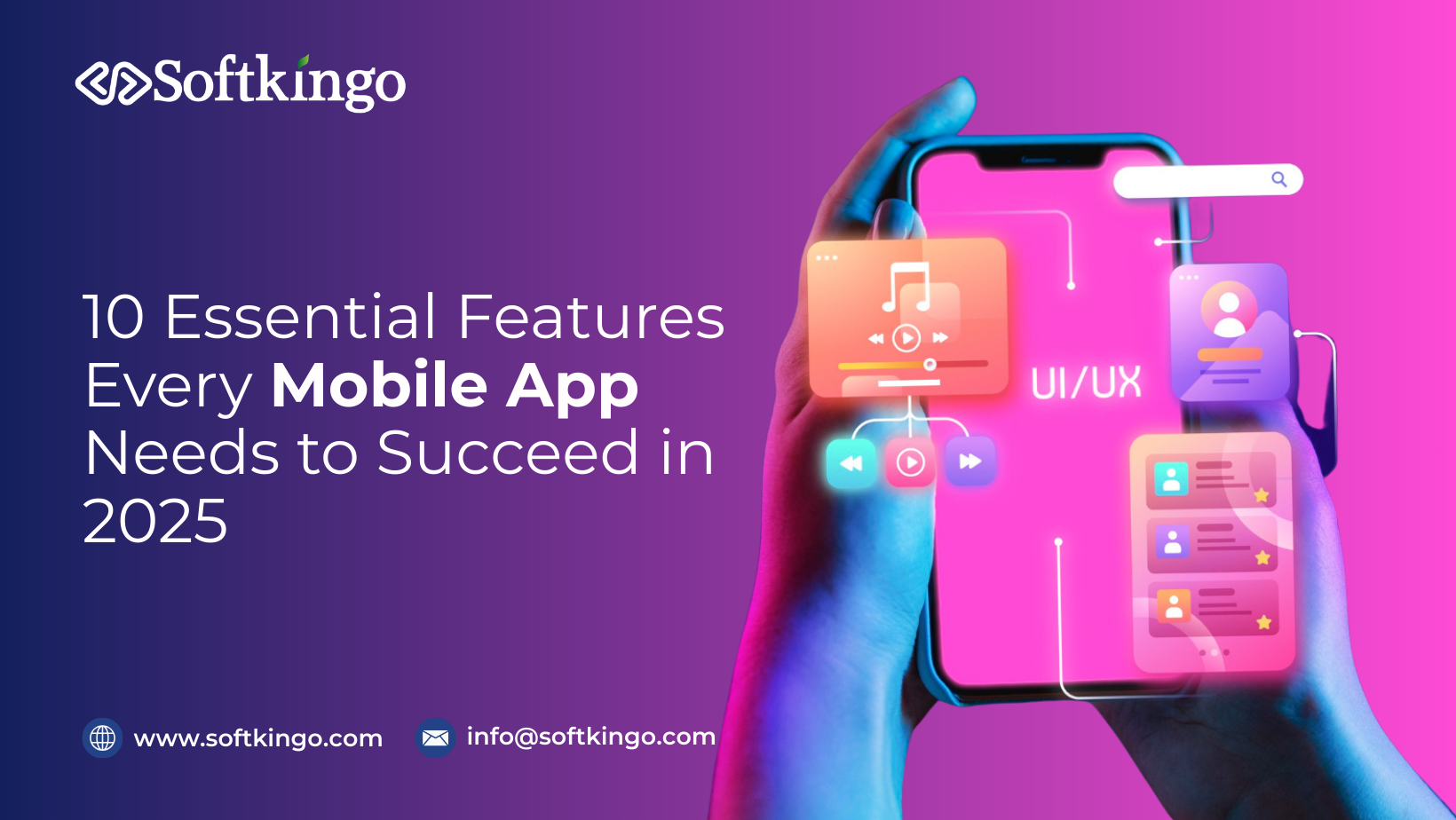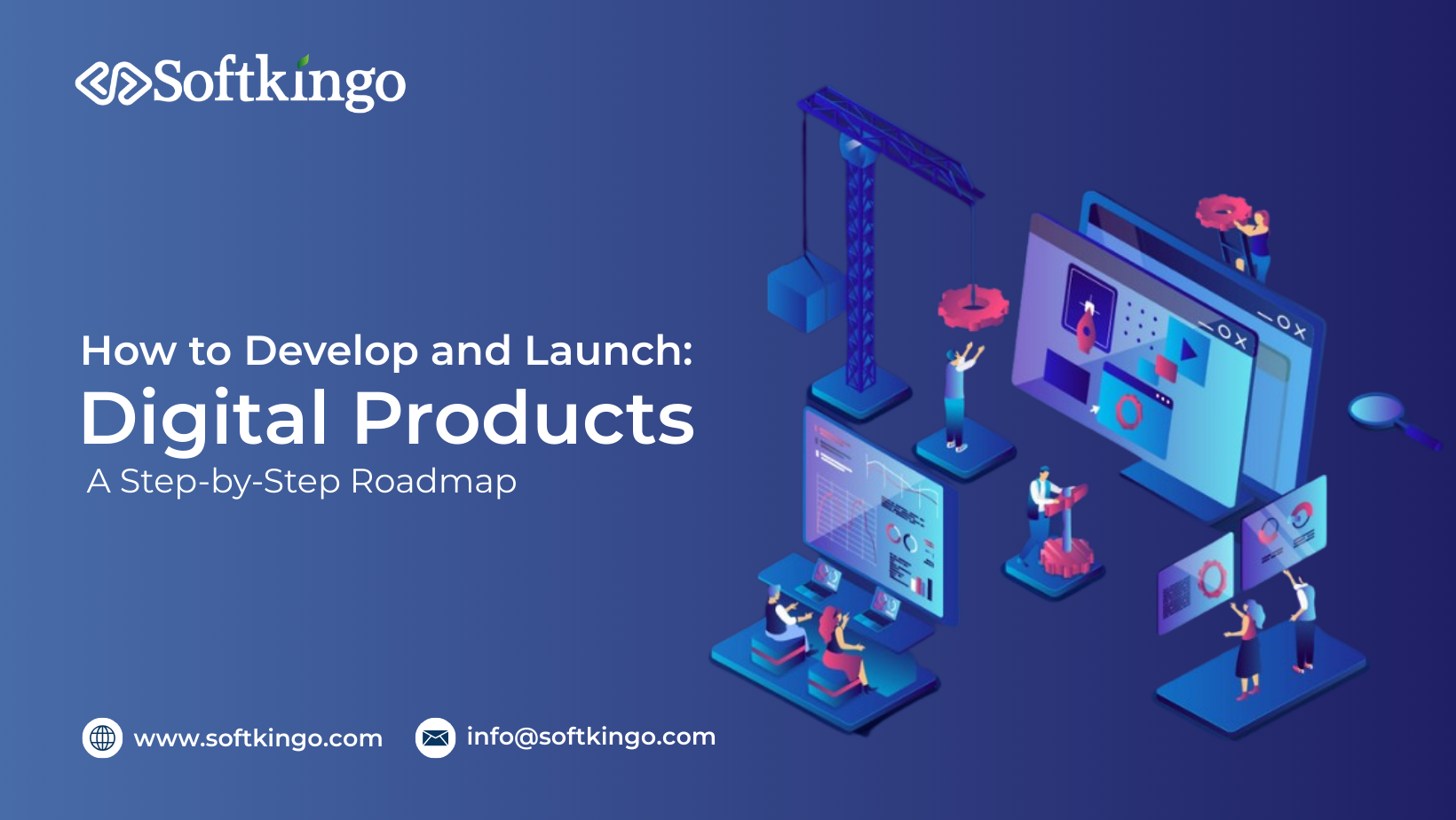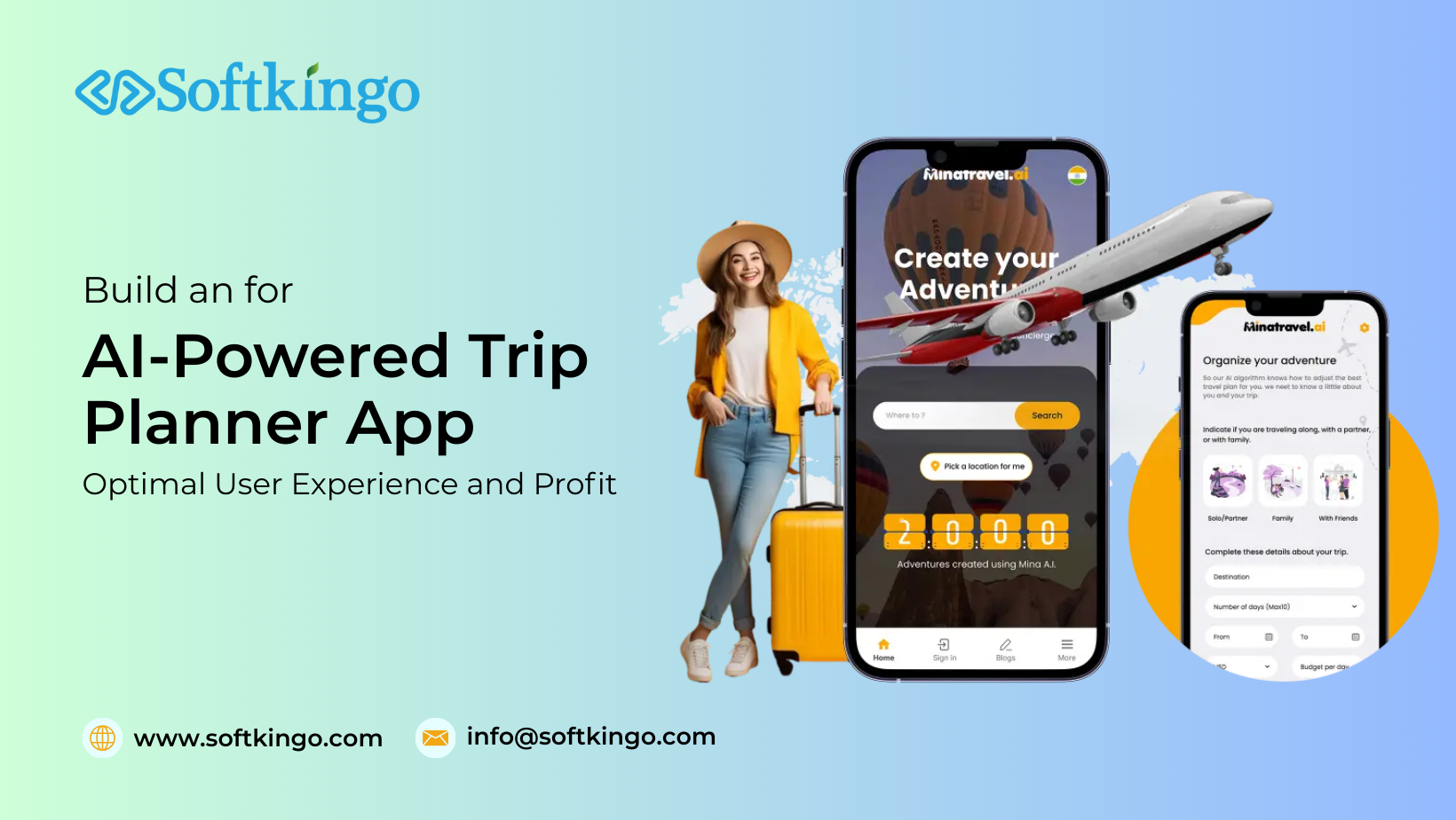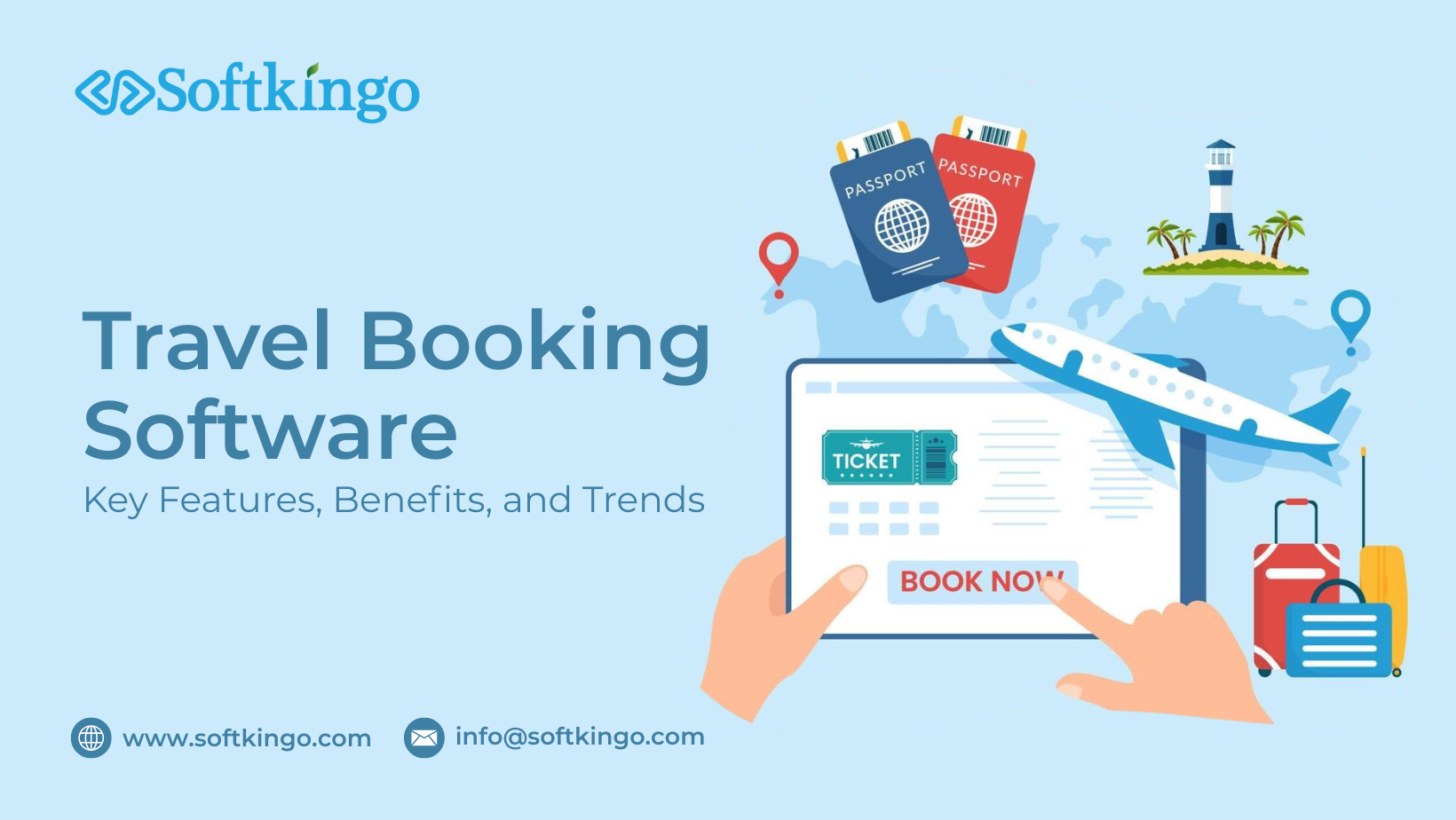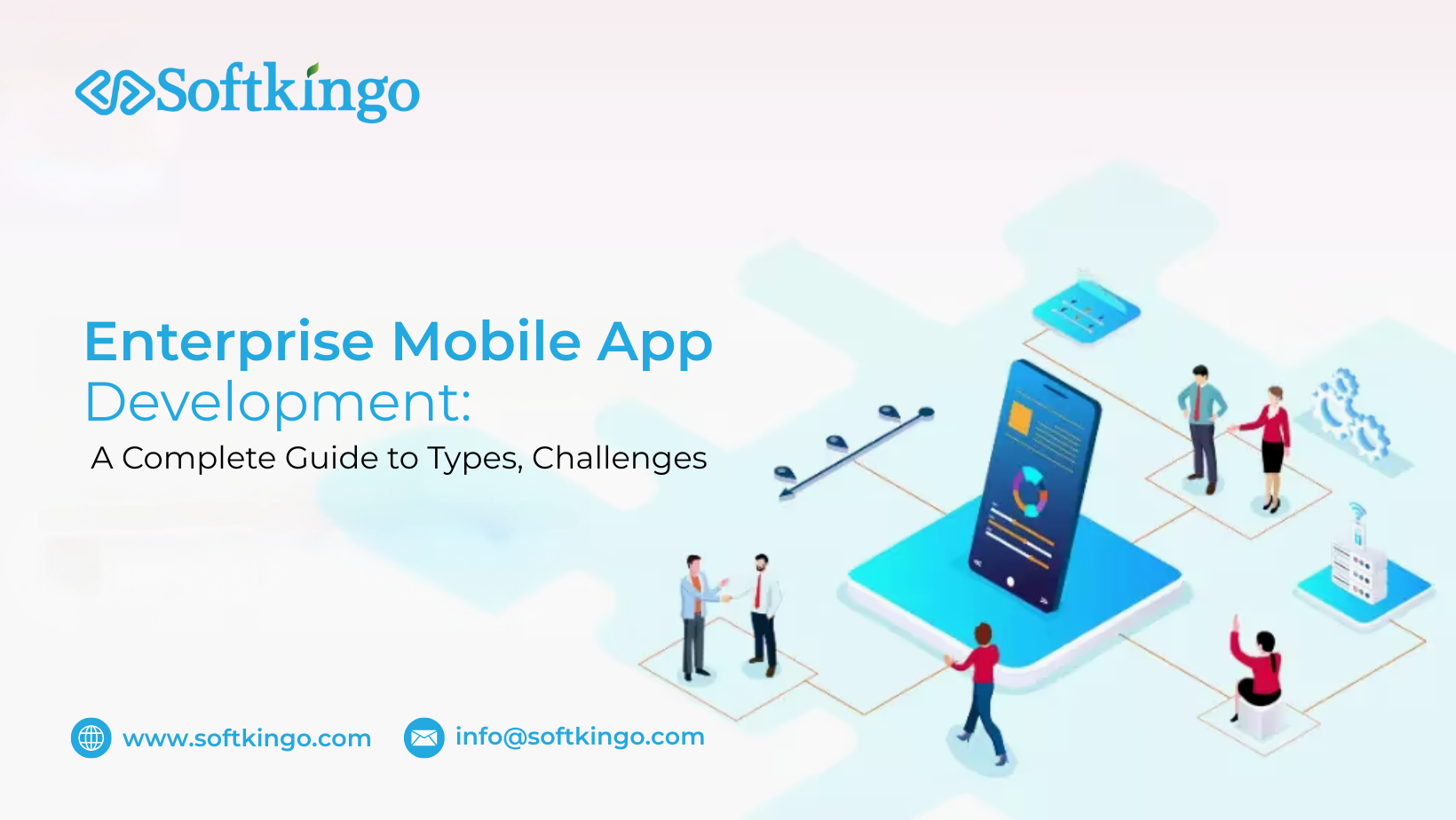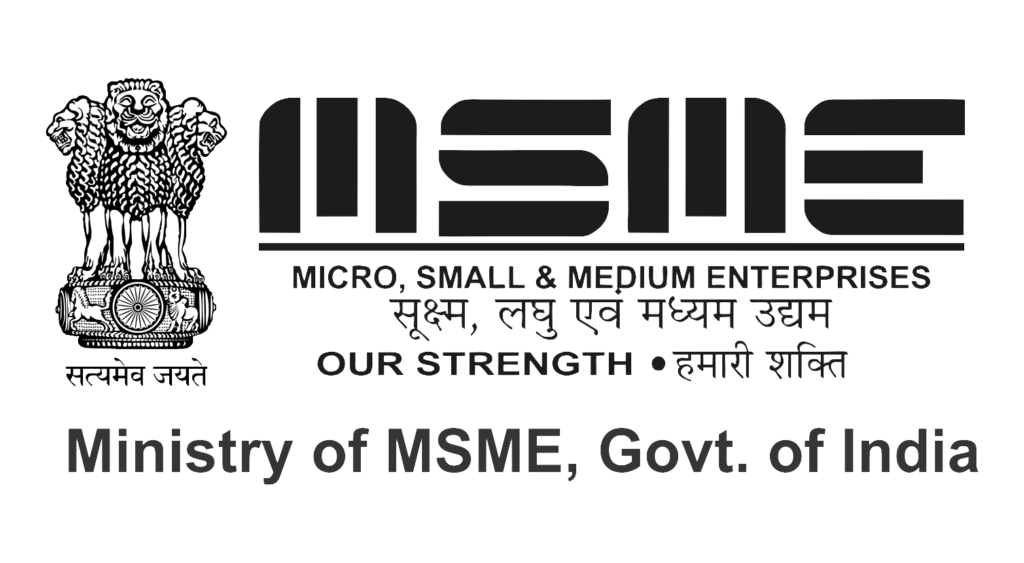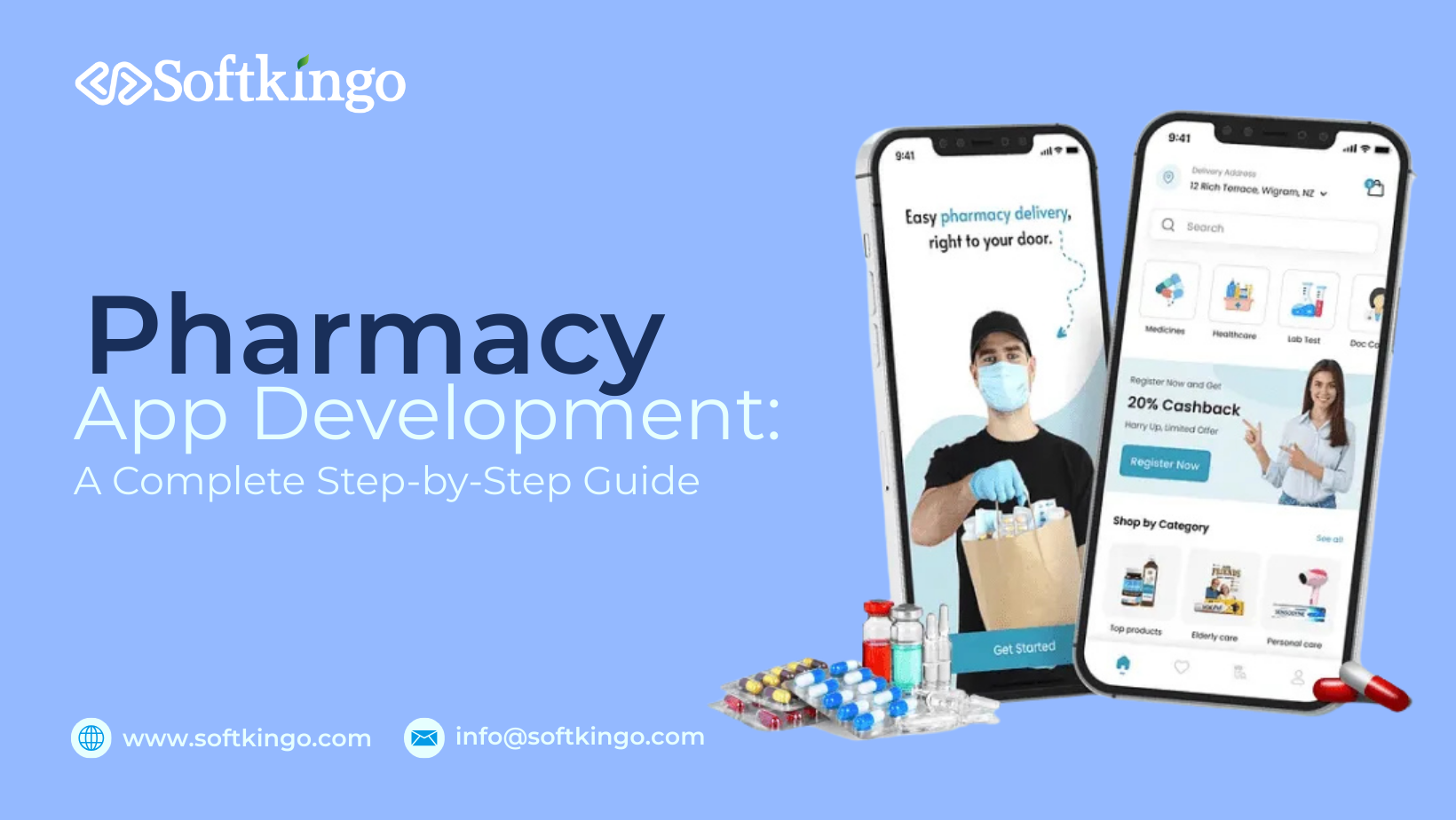
Does your partner have a habit of sending you shopping lists when they’re busy? The last time I received a medication list, I thought, “This requires an on-demand app.” Imagine! Since then, my family has been purchasing their medications exclusively via mobile apps, and I’m very excited about it.
If you’re a big fan of on-demand mobile apps and want to learn how to create a pharmacy app that will delight your customers, read on. We’ll explain the basics and share some insights.
Key Points:
- Using e-pharmacy app development solutions can significantly increase pharmacy distribution and drive growth. By adopting digital strategies, pharmacy chains can tap into the vast potential of the e-pharmacy market and offer a seamless and convenient shopping experience for their customers. Pharmacy app developers play a vital role in this evolution: they help address integration challenges, scalability, and regulatory changes, while ensuring a user-friendly and feature-rich app.
- To develop an e-pharmacy app, you need to create two mobile apps (iOS and Android) and one web app to manage them. You can also consider a separate messaging app, but this is optional.
- The main challenge when developing a pharmacy app is obtaining approval from all stakeholders, as the app must be synchronized and integrated with administrative processes. Without this, the administrative workload will increase significantly.
E-Pharmacy App Market Overview
The e-pharmacy market is experiencing continuous growth. It grew from $50 billion in 2018 to $68 billion in 2020 and is expected to reach $178 billion by 2026, a 250% increase.
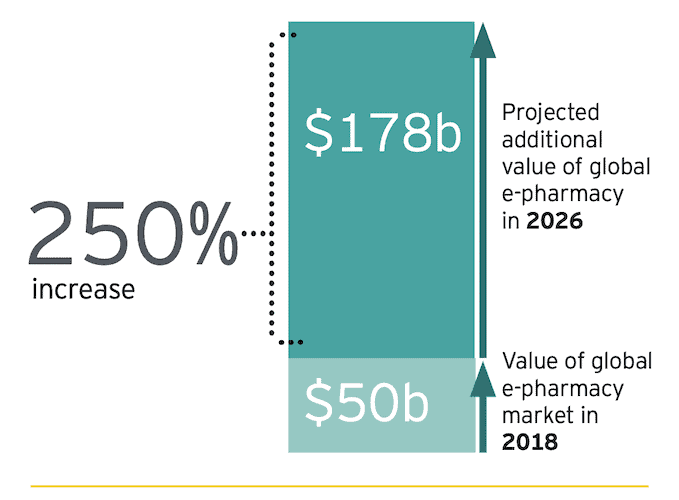
At the same time, the mHealth app market demonstrates rapid development too:
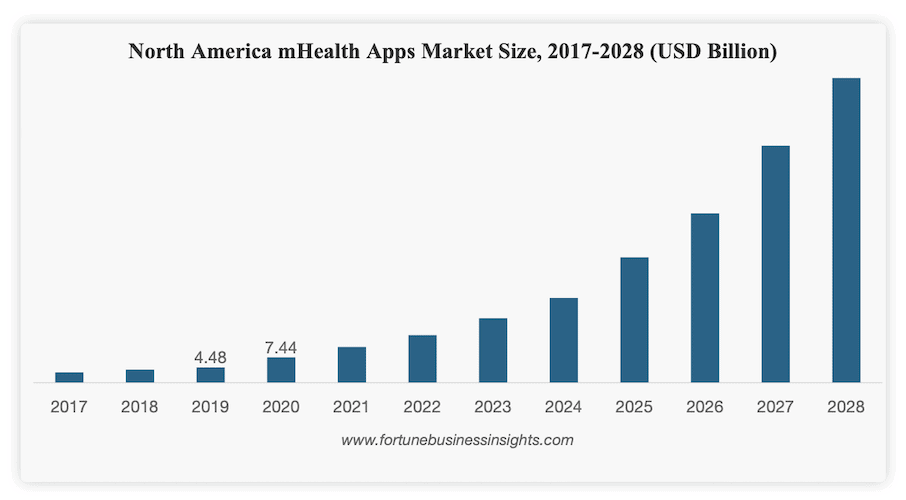 Interestingly, the epharmacy market still lags well behind in this process. According to the most recent research by Research2Guidance 2022 (Digital Health Business Outlook 2022), pharmaceutical apps (as part of digital pharmacies) are least likely to become a key trending digital health topic in 2022:
Interestingly, the epharmacy market still lags well behind in this process. According to the most recent research by Research2Guidance 2022 (Digital Health Business Outlook 2022), pharmaceutical apps (as part of digital pharmacies) are least likely to become a key trending digital health topic in 2022:
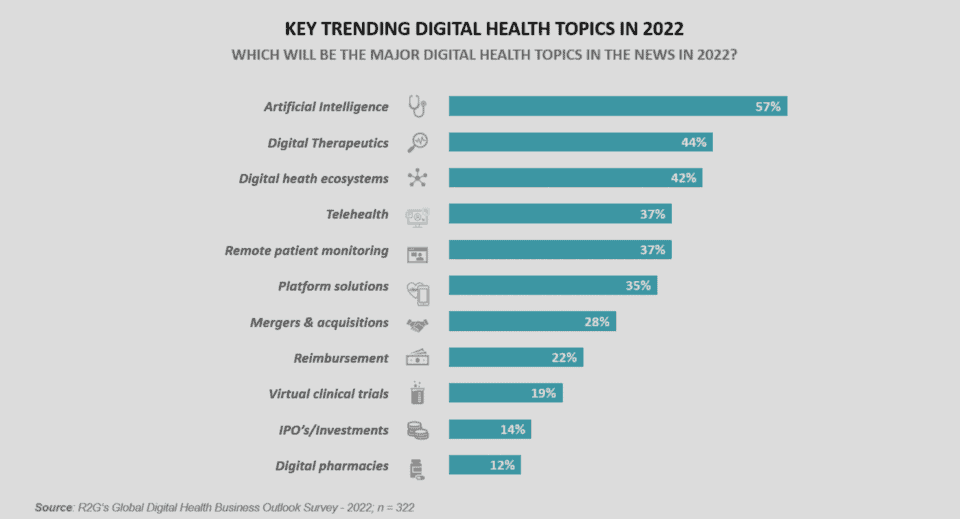
Are you expecting a 12% decline? I don’t know your opinion, but it seems like a golden opportunity. There’s still tremendous potential to be tapped.
The COVID-19 pandemic has made us so accustomed to mobile shopping and contactless on-demand delivery services that we expect nothing less from pharmaceutical companies. Ernst & Young reports that 75% of customers expect the same level of service from their healthcare providers as they receive from other companies.
The global e-pharmacy market, estimated at $51.5 billion in 2021, is expected to grow at a compound annual growth rate (CAGR) of 16% between 2023 and 2032.
- Tech giants like Google and Amazon have high hopes for pharmacy e-commerce:
- Amazon acquired PillPack, a leading online pharmacy, in 2018.
- Wing, a drone delivery service owned by Google and Alphabet, partnered with Walgreens to launch a drone delivery service in the Dallas-Fort Worth area in April 2022.
Furthermore, a survey conducted by the National Association of Community Pharmacists revealed that more than 80% of adults prefer a local pharmacist over mail-order services. (We’ll discuss how to leverage this preference in more detail when discussing the features of apps related to pharmacy software development.)
Soon, pharmacies will have no choice but to digitize their services by developing a pharmacy app.
Of course, simply understanding the market isn’t enough to create your own medication delivery app. I hope this guide to developing an online pharmacy app is helpful. However, working with professional app developers is just as important, if not more so. These experts can share their best practices and ensure that your app isn’t just an app added to an app store, but one that revolutionizes the online pharmacy industry. With their guidance, you can create an app that combines convenience, ease of use, and security, taking your pharmacy business to new heights.
Types of Pharmacy Apps
The options are limited. You can create an app for your pharmacy chain (think of it as a mobile store), or launch an aggregator app that aggregates products from different pharmaceutical companies.
This will give you an e-commerce app that allows customers to purchase medications, which is the primary use case for on-demand pharmacy apps.
As we delve deeper into the diversity of pharmacy apps, it’s important to highlight the growing importance of developing online medication delivery apps. These apps are not only convenient, but they also revolutionize the customer experience. They offer users the following features:
- Order medications with just a few clicks
- Track your order instantly
- Receive your medications directly from home
As impressive as these features are, their effectiveness depends on users’ confidence in the management of their personal data. In the digital age, ensuring optimal data security is crucial. The goal is to create an app that balances convenience, customization, and security. This could help attract the 80% of customers who prefer to buy their medications locally rather than online.
Honestly, I can imagine another business model. You could partner with a medical clinic and integrate their healthcare services directly into your mobile pharmacy app. For example, patients could receive prescription medication consultations directly within the app by chatting with their doctor via video call. Mobile pharmacy solutions could also integrate lab tests and diagnostics.
Benefits of Building a Pharmacy App
To a casual customer, a medicine delivery app is a real boon. And not only to proverbial millennials. According to a 2020 AARP report, Americans aged 50 and older actively adopt consumer technology at rates close to those aged 18–49.
What about the benefits for pharmacies?
Increase sales
There are plenty of reasons to expect higher sales after building a pharmacy app:
- Convenience of couch-commerce (aka mobile shopping)
- Cross-selling and upselling based on user behavior
- Lower costs of running/testing marketing campaigns
- Geographic expansion across the country
Improve customer loyalty
People love the convenience and stick with brands that bring lower prices and freedom of choice. In other words, help your customers avoid standing in lines, and they will praise you.
Lower operating costs
When everybody opts for an Uber economy, with goods and services arriving at their doorstep, can you get by with fewer resources at your brick-and-mortar locations? A pharmaceutical mobile app synced with a web portal will offer:
- full transparency into your business performance and staff productivity
- optimized internal processes, e.g., inventory management
As we wrap up our discussion on the benefits of building a pharmacy app, it’s worth noting that these advantages extend to medicine delivery software as well. When you develop a medicine delivery app, incorporating multiple payment options is just as crucial. It’s all about giving customers the freedom to choose their preferred payment method, thereby enhancing their overall experience and satisfaction. After all, in today’s fast-paced world, convenience is king!
Pharmacy apps must meet regulatory standards, and partnering with a custom mobile app development company ensures compliance and usability.
Top 3 Pharmaceutical Mobile Applications
Before you build your own pharmacy app, let’s review top pharma apps and see if we can borrow any product development ideas for our custom pharma app. Unfortunately, mobile apps from pharmaceutical companies rarely make it to the top charts, so we have to go by monthly downloads. Walgreens (500K), CVS Pharmacy (400K), and Rite Aid Pharmacy (50K) are all top performers.
The pandemic caused a significant surge in downloads for these pharma applications, and they remain popular.
Walgreens
You couldn’t expect less from the second-largest pharmacy store chain in the U.S., right? The app allows customers to shop for meds and manage prescriptions.
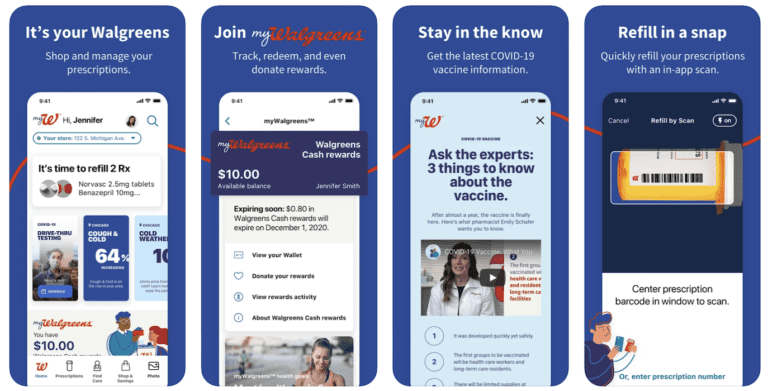
Key features (besides shopping and tracking the delivery status):
- Refill prescriptions by scanning a barcode
- Pill reminders
- Consultations with healthcare providers
- Rewards and other perks
CVS Pharmacy
CVS is an app from the #1 pharmacy chain in the U.S. And it has definitely raised the bar for on-demand mobile pharmacy software.
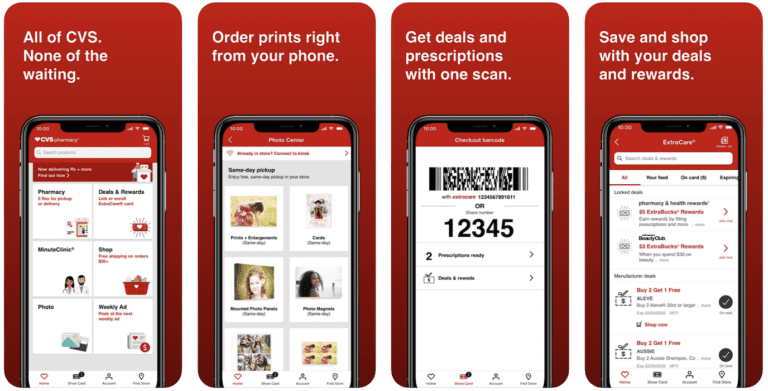 Key features:
Key features:
- Prepay for prescriptions for more private pickup
- Check drug information and interactions
- Video chat with a health care provider 24/7
- Order refills and prescription history
Rite Aid Pharmacy
Rite Aid is another well-known pharmacy network with a pharma app which has been around since 2012.
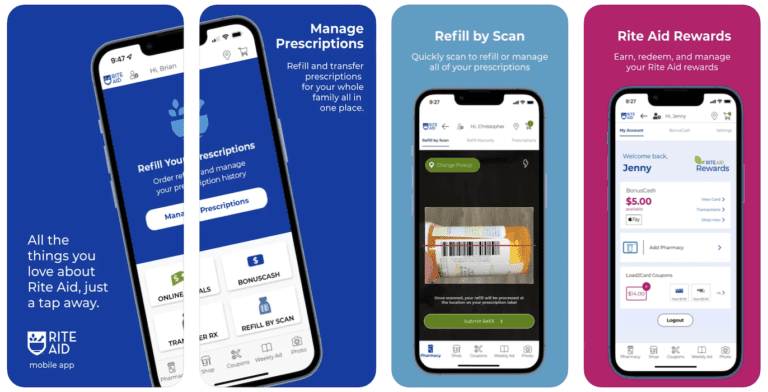 Key features:
Key features:
- prescription reminders
- manage family members’ prescriptions
- medical store locator
- track bonus points balance
I encourage you to try out these leading mobile pharmacy marketplaces for buying medicines and pharmacy delivery so that you can get a feel of their UX/UI.
As we wrap up our exploration of the top 3 pharmaceutical mobile applications, let’s not forget the potential of on-demand medicine delivery app development. The future of healthcare lies in the palms of our hands – mobile and web platforms that bring pharmacies to our doorstep. With such apps, getting necessary medicines becomes not just convenient, but also efficient and timely. Isn’t that what true healthcare innovation should be all about?
Must-Have Features of an Online Pharmacy App
All software has some typical features it can’t live without. What are the most common options people expect to find in a pharmacy app? Keep the following list at your fingertips as you embark on your online medicine app development journey, ensuring your software meets user expectations.
Sign-on and profile
We need an easy way to onboard new customers and store their data in the app: address, payment options, rewards balance, email address, etc. This helps us personalize their experience and ensure uninterrupted service.
E-commerce
E-commerce (or m-commerce, if you will) encompasses all features related to shopping:
- payments
- catalog of medicine
- shopping cart
- order history
- smart-search with filters and previous searches
In the rapidly evolving digital world, pharma application development has emerged as a game-changer. It’s not just about digitizing the pharmacy experience; it’s about making the process more customer-centric. A key component of this is offering multiple payment options within the app. By doing so, pharmacies can cater to a wider audience with varying preferences, truly embodying the spirit of personalized healthcare.
Prescription management
Users should be able to add their prescriptions to the app, and pharmacists will either verify them manually or with the help of AI/ML algorithms. By harnessing the power of artificial intelligence, these applications can also provide personalized medication recommendations and reminders, thereby enhancing patient adherence to their treatment plans.
Order tracking
Consumers have really come to love tracking delivery in real-time on a map à la DoorDash and in similar delivery apps, especially after COVID-19 lock-downs.
Notifications
Push notifications and medicine reminders keep customers engaged, prompting them to take pills, order medicines, or get discounts.
Localization
Multi-language support will help you reach larger audiences. Please note that this should be addressed from the get-go because the cost of adding new languages will increase dramatically once the app is ready. Make sure to partner with the right pharmacy app development company for that.
Advanced Features of a Pharma App
Now let’s review more advanced functionality that’s relevant for pharmaceutical app development. Rather than being stand-alone features, these options typically enhance usability by extending the basic functionality. For example, you can allow users to compare prices if your app aggregates meds from different chains.
Barcode scanning
This can be useful to quickly get info about prescription drugs, order a refill, or make a payment at a store.
Chat or video calls
Real-time customer support right inside the app boosts consumer confidence and makes patient assistance more accessible. In addition, you can offer telemedicine consultations with doctors or pharmacists.
Pickup orders
Paying for medicine in advance and then picking it up at a store is another advanced option your customer base may appreciate.
Social interactivity
Some customers love to share their experiences with other people on social media. Therefore, allowing them to comment and review different products may prove beneficial.
Family accounts
An option to track medication adherence for senior family members and stock them up on meds from their separate apps can be a real blessing for many users.
Accessibility features
Apple and Google provide many tools for making mobile apps more accessible and inclusive. However, such an initiative goes way beyond a single option and should permeate all features.
Mobile wallet
You can also set up a mobile wallet so users can up their balances and turn on automatic refills. That’s also where you integrate health insurance coverage options and rewards.
Web portal for the business
Pharmacists and management will need a web application to manage quite a few things on their end, too:
- order management
- inventory management
- prescription verification
- EHR integration
- reports and analytics
- CMS for content management
- CRM to manage profiles
- marketing tools for running promos and ads
Access to different areas of the pharmacist panel can be restricted based on user roles.
As we’ve explored, the world of medicine delivery mobile app development is vast and full of potential. The incorporation of additional features can significantly enhance the user experience, making your app not just a tool, but a companion in health management.
But remember, successful implementation of these features requires professional development services. So, whether you’re considering barcode scanning, chat or video call capabilities, social interactivity, or a web portal for business, ensure you engage experts who can navigate the complexities of this domain. After all, your goal is to make healthcare more accessible, and every feature should contribute to that mission.
Challenges of Developing an Online Pharmacy App
Developing an online pharmacy app faces many challenges. Consider the following key factors:
Stakeholder Support
All team members must collaborate on developing an online pharmacy app. This should include key stakeholders from sales, marketing, accounting, and other departments, as this is the only way to improve efficiency in the pharmaceutical industry.
Preparing for Scale From Day One
The app must be designed to ensure seamless scalability. In fact, it cannot be disconnected from the network after a massive increase in customer base after launch. Ideally, the app’s infrastructure should automatically scale vertically and horizontally based on the number of active users. Ask your team of home delivery app development experts:
- How will they use microservices to enhance app security?
- Their approach to database management and optimization
- Using cloud services to allocate resources flexibly, with the ability to scale up or down as needed.
Integration with existing e-commerce channels
Some pharmacies will likely have an e-commerce portal when launching their apps. Therefore, it is advisable to integrate it with content management systems (CMS) and other existing systems to update content simultaneously across both mobile and web applications.
Responsive User Interface
How do you design a pharmacy app that appeals to baby boomers and millennials? The solution: a personalized, responsive, and user-friendly user interface.
A Constantly Evolving Regulatory Environment
Data security regulations are constantly evolving. Being prepared for regulatory compliance means implementing proven DevSecOps processes to secure healthcare data during development and after launch, when it reaches customers.
When developing apps for the pharmaceutical industry, it is important not only to keep up with these ever-changing regulations but also to have the ability and foresight to adapt quickly. This ensures the app is compliant and reliable for users, thereby protecting their health information and the company’s reputation.
5 Steps to Creating an Online Pharmacy App
Regarding software development, developing an online pharmacy app isn’t much different from developing other apps. However, there are a few things to keep in mind:
We’re not just developing a mobile app.
First, we need to support iOS and Android to reach the largest possible number of users. Additionally, we’ll integrate an existing e-commerce platform or create a web-based admin panel from scratch for doctors and administrators.
HIPAA compliance is crucial
We must adhere to HIPAA requirements when developing online pharmacy software. This includes protecting confidential patient information in applications (web and mobile) and providing development and testing environments.
Keep design and development in one place
Over the past ten years, I’ve seen many projects fail or struggle to launch on time, simply because design and development were handled by different teams.
Use recommended third-party solutions
When developing a pharmacy app, we’ll work on many features that don’t require a full build. Barcode scanning, map geolocation, chat, and many other options can be implemented using proven third-party libraries.
Follow Agile Development Principles
Finally, to launch an app on time and achieve widespread adoption, it’s essential to follow an agile approach. Moreover, this approach will prove its worth if we consistently apply it.
Let’s now review the concrete steps for developing an e-pharmacy app. Our regular readers are surely familiar with them:
- Phase 1: Discovery: We delve into the specific needs of your project.
- Phase 2: Prototyping: As the concept is developed, our creativity flows.
- Phase 3: Development: Our developers design your code to transform the prototype into a fully functional app. Phase 4: Launch: We make your innovative e-pharmacy app available to the world.
- Phase 5: Maintenance: We continually improve and update your app to keep it at the forefront of the industry.
Phase 1: Exploration
The first step involves defining your target audience, setting ROI goals, selecting a technology stack (with a skilled development team), and creating a feature list.
Phase 2: Prototyping
Next, we conceptualize all options by creating an interactive prototype and sharing it with our clients. Based on their feedback, we refine the UI/UX design without writing a single line of code, allowing us to adhere to the allocated development budget.
Phase 3: Development
Developers write code, QA engineers run tests, and DevOps engineers ensure that programmers and testers have a well-organized infrastructure. We highly recommend using a cross-platform development framework like React Native or Flutter to reduce the cost of the development phase.
This process is iterated in small phases, gradually bringing the applications to life. Please note that we will be working simultaneously on a web portal and a mobile application for pharmacists/administrators.
Phase 4: Launch
Once our minimum viable product (MVP) is ready, we can launch the application in a selected market to test its performance. Then we will gradually release it to our other customers.
Phase 5: Maintenance
Maintenance is the final phase, but it overlaps with the prototyping and development phases. This phase includes bug tracking and improving the application’s performance, as well as adding new features. To correct the first step and implement the second, we must (sometimes) return to prototyping, and then (systematically) return to development iterations.
In the ever-changing world of digital health, clinical pharmacy app development is not limited to creating a practical application; it involves continuous innovation, improvement, and customization based on the changing needs of users and the healthcare industry.
Emerging Trends in Pharmacy Apps
In the age of digital health, pharmacy apps are no longer just about dispensing medications. They’re becoming smarter, more intuitive, and more integrated, offering a complete healthcare experience at your fingertips. What’s driving this change? Let’s explore some emerging trends to consider when developing mobile pharmacy apps.
Harnessing the Power of Big Data
With the Internet of Things (IoT) connecting us more than ever, we have a wealth of data to tap into. Smart pharmacy apps leverage this wealth of data to anticipate medication needs, optimize delivery routes, and even improve customer segmentation. Isn’t it amazing how technology can transform raw data into actionable insights?
An Integrated Healthcare Solution with Telemedicine
Imagine: You need to refill your prescription, but you’re unsure of the dosage. Wouldn’t it be convenient to be able to consult a doctor immediately? Integrating telemedicine with pharmacy apps offers just that: a seamless blend of consultation and dispensing. AI-Powered Personalization
Have you ever dreamed of your pharmacy app better understanding your needs? Thanks to AI, it’s now possible. AI algorithms provide personalized suggestions by analyzing your past purchases and health status. It’s like a personal pharmacist, always ready to help!
In short, the future of pharmacy apps lies in smart integration and personalization, powered by the Internet of Things and AI. As we shift toward digital health, who knows what other innovations will emerge? What do you think is the next big trend in pharmacy software for home delivery app development?
How much does it cost to develop a pharmacy app?
The initial price for an MVP version ranges between $120,000 and $210,000, depending on the features you want to include in your purchasing app and web portal.
But the investment isn’t limited to developing a medicine ordering app; post-launch maintenance and updates are equally important. Regular app updates fix bugs and improve performance, while ensuring compliance with the latest regulations and meeting user expectations.
If you have an idea for a mobile pharmacy app and would like advice on implementing it, contact our experts.
Paramhans Singh is the CEO and founder of Softkingo Technologies, bringing over 8 years of experience in delivering custom software solutions that help startups and enterprises achieve their business goals. He has successfully validated more than 220 app and website ideas and delivered over 100 tailored solutions, utilizing a range of technologies such as Swift, Kotlin, React Native, Flutter, PHP, RoR, IoT, AI, NFC, AR/VR, Blockchain, and NFTs.



